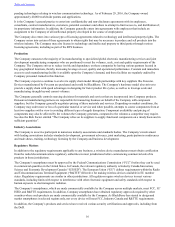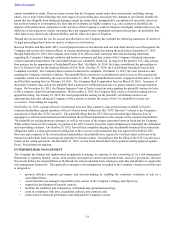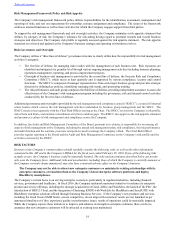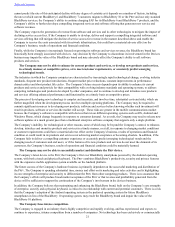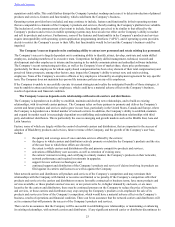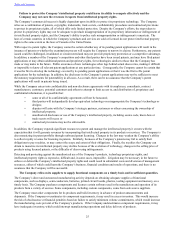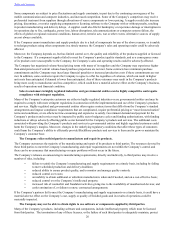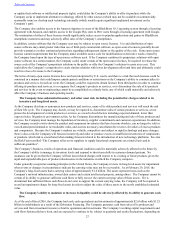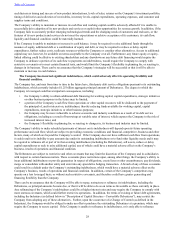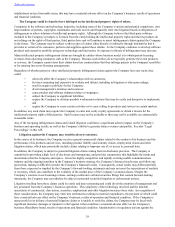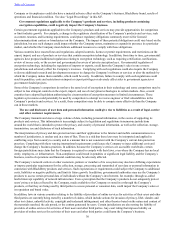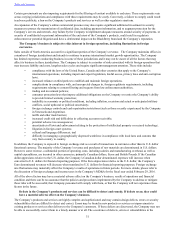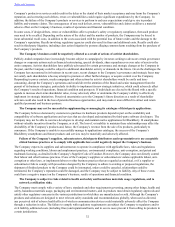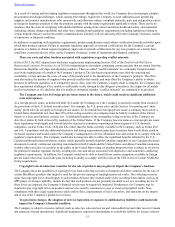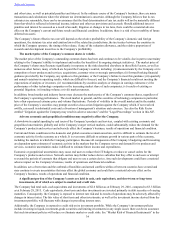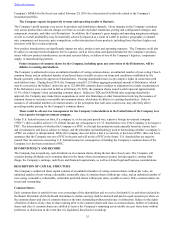Blackberry 2016 Annual Report Download - page 35
Download and view the complete annual report
Please find page 35 of the 2016 Blackberry annual report below. You can navigate through the pages in the report by either clicking on the pages listed below, or by using the keyword search tool below to find specific information within the annual report.
Table of Contents
26
Some components are subject to price fluctuations and supply constraints, in part due to the continuing convergence of the
mobile communication and computer industries, and increased competition. Some of the Company’s competitors may receive
preferential treatment from suppliers through allocations of scarce components or lower pricing. A supplier could also increase
pricing, discontinue, or restrict supplying components or licensing software to the Company with or without penalty, resulting
in product manufacturing and delivery delays. A supplier could also file for bankruptcy or experience damage or interruption in
its operations due to fire, earthquake, power loss, labour disruptions, telecommunications or computer systems failure, the
effects of global or regional economic conditions, human error, terrorist acts, war or other events. Alternative sources of supply
are not always available.
If the Company cannot manufacture and supply products due to a lack of components for any of the above reasons, or is unable
to redesign products using other components in a timely manner, the Company’s sales and operating results could be adversely
affected.
Moreover, the Company depends on, but has limited control over, the quality and reliability of the products supplied or licensed
to the Company. If a component supplier failed to meet the Company’s product quality standards, and as a consequence some
of its products were unacceptable to the Company, the Company’s sales and operating results could be adversely affected.
The Company has negotiated volume-based pricing terms with many of its suppliers and the Company may experience higher
than anticipated costs if current volume-based purchase projections are not met. Some contracts have minimum purchase
commitments and the Company may incur large financial penalties or increased production costs if these commitments are not
met. In addition, some contracts require the Company to agree to a flat fee regardless of volumes, which can result in higher
unit costs than anticipated if demand is lower than anticipated. Any of these outcomes may result in the Company’s products
being more costly to manufacture and less competitive, which could have a material adverse effect on the Company’s business,
results of operations and financial condition.
Sales to customers in highly regulated industries and governmental entities can be highly competitive and require
compliance with stringent regulation.
Many of the Company’s enterprise customers are either in highly regulated industries or are governmental entities and may be
required to comply with more stringent regulations in connection with the implementation and use of the Company’s products
and services. Highly regulated and governmental entities often require contract terms that differ from the Company’s standard
arrangements and impose compliance requirements that are complicated, require preferential pricing or “most favoured nation”
terms and conditions, or are otherwise time-consuming and expensive to satisfy. Government demand and payment for the
Company’s products and services may be impacted by public sector budgetary cycles and funding authorizations, with funding
reductions or delays adversely affecting public sector demand for the Company’s products and services. The additional costs
associated with providing the Company’s products and services to governmental entities and highly regulated customers could
harm the Company’s margins. Moreover, changes in the underlying regulatory conditions that affect these types of customers
could harm the Company’s ability to efficiently provide BlackBerry products and services to them and to grow or maintain the
Company’s customer base.
The Company relies on third parties to manufacture and repair its products.
The Company outsources the majority of the manufacturing and repair of its products to third parties. The resources devoted by
these third parties to meet the Company’s manufacturing and repair requirements are not within the Company’s control and
there can be no assurance that manufacturing or repair problems will not occur in the future.
The Company’s reliance on outsourcing its manufacturing requirements, directly and indirectly, to third parties may involve a
number of risks, including:
• failure to satisfy the Company’s manufacturing and supply requirements on a timely basis, including by failing
to meet scheduled production and delivery deadlines;
• reduced ability to ensure product quality, and to monitor and manage quality controls;
• reduced control over costs;
• an inability to obtain additional or substitute manufacturers when and if needed, and on a cost-effective basis;
• reduced control over the Company’s intellectual property;
• increased risk of counterfeit and fraudulent activities giving rise to the availability of unauthorized devices; and
• early termination of, or failure to renew, contractual arrangements.
If the Company’s partners fail to meet the Company’s manufacturing and supply requirements on a timely basis, it could have a
material adverse effect on the Company’s cost, supply or quality of finished goods and its results of operations could be
materially impacted.
The Company may not be able to obtain rights to use software or components supplied by third parties.
Many of the Company’s products, including software and components, include intellectual property which must be licensed
from third parties. The termination of any of these licenses, or the failure of such third parties to adequately maintain, protect


